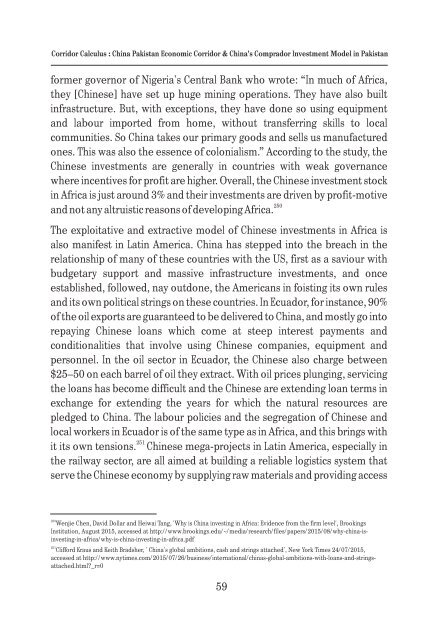Corridor Calculus
corridor-calculus-china-pakistan-economic-corridor-and-china-s-comprador-investment-model-in-pakistan
corridor-calculus-china-pakistan-economic-corridor-and-china-s-comprador-investment-model-in-pakistan
Create successful ePaper yourself
Turn your PDF publications into a flip-book with our unique Google optimized e-Paper software.
<strong>Corridor</strong> <strong>Calculus</strong> : China Pakistan Economic <strong>Corridor</strong> & China's Comprador Investment Model in Pakistan<br />
former governor of Nigeria's Central Bank who wrote: “In much of Africa,<br />
they [Chinese] have set up huge mining operations. They have also built<br />
infrastructure. But, with exceptions, they have done so using equipment<br />
and labour imported from home, without transferring skills to local<br />
communities. So China takes our primary goods and sells us manufactured<br />
ones. This was also the essence of colonialism.” According to the study, the<br />
Chinese investments are generally in countries with weak governance<br />
where incentives for profit are higher. Overall, the Chinese investment stock<br />
in Africa is just around 3% and their investments are driven by profit-motive<br />
250<br />
and not any altruistic reasons of developing Africa.<br />
The exploitative and extractive model of Chinese investments in Africa is<br />
also manifest in Latin America. China has stepped into the breach in the<br />
relationship of many of these countries with the US, first as a saviour with<br />
budgetary support and massive infrastructure investments, and once<br />
established, followed, nay outdone, the Americans in foisting its own rules<br />
and its own political strings on these countries. In Ecuador, for instance, 90%<br />
of the oil exports are guaranteed to be delivered to China, and mostly go into<br />
repaying Chinese loans which come at steep interest payments and<br />
conditionalities that involve using Chinese companies, equipment and<br />
personnel. In the oil sector in Ecuador, the Chinese also charge between<br />
$25–50 on each barrel of oil they extract. With oil prices plunging, servicing<br />
the loans has become difficult and the Chinese are extending loan terms in<br />
exchange for extending the years for which the natural resources are<br />
pledged to China. The labour policies and the segregation of Chinese and<br />
local workers in Ecuador is of the same type as in Africa, and this brings with<br />
251<br />
it its own tensions. Chinese mega-projects in Latin America, especially in<br />
the railway sector, are all aimed at building a reliable logistics system that<br />
serve the Chinese economy by supplying raw materials and providing access<br />
250<br />
Wenjie Chen, David Dollar and Heiwai Tang, 'Why is China investing in Africa: Evidence from the firm level', Brookings<br />
Institution, August 2015, accessed at http://www.brookings.edu/~/media/research/files/papers/2015/08/why-china-isinvesting-in-africa/why-is-china-investing-in-africa.pdf<br />
251<br />
Clifford Kraus and Keith Bradsher, ' China's global ambitions, cash and strings attached', New York Times 24/07/2015,<br />
accessed at http://www.nytimes.com/2015/07/26/business/international/chinas-global-ambitions-with-loans-and-stringsattached.html?_r=0<br />
59


